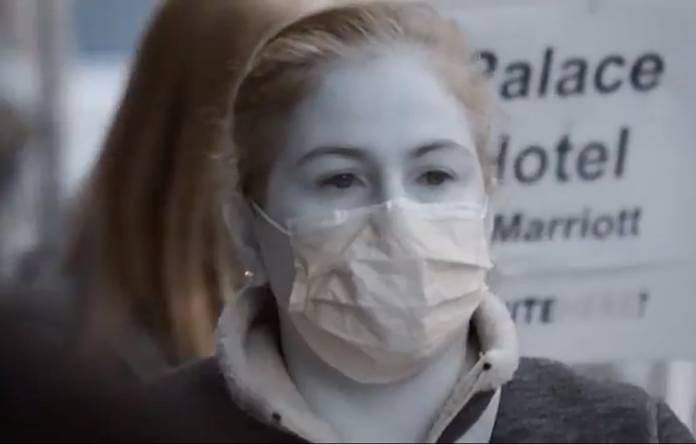It looks like a zombie movie, except it was real life for millions in the Bay Area and California in general. As our hearts went out to the residents of the areas obliterated by this past month’s fires, San Franciscans donned protective n95 masks (if they could find any) against the stubborn, toxic cloud of smoke the fires generated for days, hunkered indoors when possible, and tried to live through a disaster that the city was completely unprepared for and that is fueling an uprising against PG&E.
While the Democratic Socialists and the Coalition on Homelessness were on the streets, handing out more masks that the city government, talented local cinematographer Jason Joseffer was documenting the phantasmagoric scene, wandering through the city capturing the apocalyptic feeling. The result is n95, a short documentary Joseffer published to YouTube a few days ago.
Everyday scenes like the labor strike at the Marriott Palace Hotel and people writing near the cable car (before it was shut down) take on a sinister glare, now crowded with masked figures and processed with an infrared filter. Ironic touches (a shot of Muni’s “clean-air vehicle” logo and a glimpse of Walgreens’ “corner of happy and healthy” marketing campaign give the film a little touch of levity—or pathos, it depends on how frustrated you were with everything. And it was frustrating.
I asked Joseffer to answer a few questions about n95 and his history of documenting San Francisco.
48hills What was the inspiration for shooting the film?
JASON JOSEFFER I grew up in San Francisco, and my only previous recollection of smoke and ash from fires was the tragic Oakland hills fire of 1991. It was a big deal and it felt like a phenomenon of the time. The past few years it feels like we have major episodes of smoke suffocating the Bay Area several times a year. It’s sad that these wildfires are becoming a norm and even something to be expected each year. I work professionally as a cinematographer and I felt compelled to throw a face mask on and capture San Francisco as the Air Quality Index hit 271. It was a spontaneous decision and the entire piece was shot over a few hours while wandering around downtown on November 16.
48H How did you choose to process the video this way (infrared), and what do you think it says about the toxic experience we went through.
JJ I had experimented with infrared cinematography while shooting a dance film a couple years back and I always wanted to explore it further. Infrared is a spectrum that the human eye can’t see, but a camera can given the right setup. I used an infrared filter in front of the digital sensor to block out visible light and allow it to see the infrared spectrum. The result is a near chromatic look with splashes of blue and orange.
The look is alien and other-worldy which is exactly how San Francisco felt as people all over the city wore respirators while venturing outside. Earlier that day, I went to a hardware store and the staff continuously announced that all N95 respirators had been sold out. Shortly after, I got a call that my upcoming shoot was cancelled due to smoke, and I was free to grab my camera and shoot downtown. Shooting in infrared was a spontaneous decision, but felt appropriate given that the city’s post-apocalyptic feel.
48H You have a very in-depth local background, what else are you working on?
JJ I grew up in San Francisco’s Excelsior district and learned photography from my father as a child. I later had a cable-access television show which triggered an interest in filmmaking and prompted me to pursue a film degree from UC Santa Cruz. I’ve been working as a cinematographer for over a decade shooting films, documentaries and commercials. Occasionally I direct my own projects and am in the fundraising stages of a feature-length documentary about the street corner of Geneva at Mission. The bustling street corner is rich with complexity and is a crossroad of culture and ideas.
See more of Joseffer’s work at www.jasonjoseffer.com




